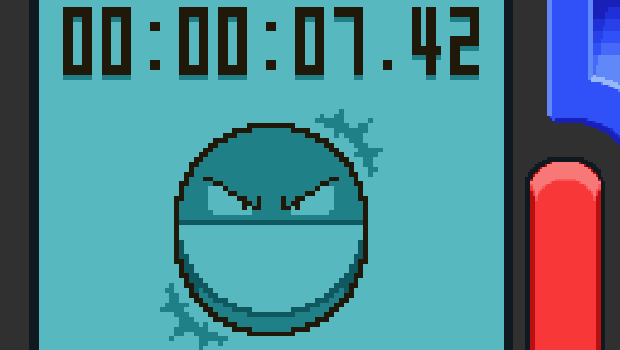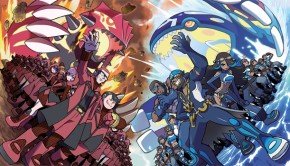Time’s Up for Rule 28.2
On the morning of June 30th hundreds of Pokémon trainers from across North America gathered at the Indiana Convention Center to compete in the 2012 United States National Video Game Championships. Before battles began, all trainers sat down and listened carefully to the officials who briefly recapped the rules and guidelines for the tournament. Some of them were basic and previously known like the battle format — doubles with Pokémon at level 50 — and others were updates to previously understood rules — two divisions of Swiss each with a top cut of 16 for a total of eight rounds. In addition to these easily understood rulings, it was also stated that intentionally stalling would be unacceptable and would result in a loss if judges deemed that a competitor was violating the obscure rule 28.2. which states:
Any mid‐game effects, such as selecting a move or retreating Pokémon, are to take place in a reasonable amount of time. If a judge feels that a player’s pace is unwarranted, that player will be subject to the Game Tempo section of the POP Penalty Guidelines.
The rule itself has been in place for some time now, but what came as a surprise to many was the possibility of its enforcement. Prior to the US National Tournament, the possibility of getting disqualified for tactics such as manipulating the built-in timer was unheard of, largely because the majority of competitive players thought the rule was unclear, hard to enforce, and just downright silly.
Still, there is a reason for the rule’s existence, and before we go any further, we need to understand how and why rule 28.2. was put into place. The Pokémon Company knows its games better than anyone else, and they’ve seen stall tactics used at countless tournaments, especially on the TCG (Trading Card Game) side. In the TCG world, there are no built-in game timers. In fact, the pace of the game is determined entirely by the players – hence there can be a need for officials to intervene. Furthermore, TCG players are not supposed to know how much time is left in a round, another way to prevent intentional stalling.
Over in the VGC arena, however, things are different. There is a built-in timer which regulates the amount of time each player has to select their team, choose their moves, and finish their battle, which makes Rule 28.2. seem more like a holdover from an era when TCG tournaments were all TPCi held. Currently the timer used for the US and European National and Regional Tournaments is set to give players 90 seconds to decide which four Pokémon they will battle with, 60 seconds to decide which moves to use per turn, and 15 minutes for the battle to finish (not including the time spent choosing a team of four). Of note, the 15 minute timer does not stop counting down after the players select their moves. This means that move animations, weather conditions, and any statuses also eat into the time players have to complete their battles.
Taking a look at these numbers, a battle should usually result in at least 10 turns (more likely, 11 or 12 with no communication issues) which allows the majority of normally paced VGC battles to be completed. However, there are several strategies that players can use to manipulate the in-game timer to their advantage. As a battle progresses, you should be getting a feel of your opponents team and your chances at victory. If you notice that you have been placed in a corner and forced to juggle your Pokémon around in an attempt to keep them alive, stalling is a tactic that can be used to achieve victory. When the timer runs out, the trainer with the most remaining Pokémon is the victor. With this in mind, if you are able to keep all four of your Pokémon alive (even at a very low HP) while taking all 60 seconds to make your move, it is possible to place yourself in a position where you KO your opponent’s last Pokémon at the end of the match and prevail due to the fact that you have more remaining Pokémon than your opponent. Chances are your opponent would have won the match if given more time, but your stall tactics have allowed you to prevail. This is just one possible scenario in which stalling creates a seemingly “unfair” situation where the better trainer ends up losing. More importantly, it illustrates that stalling is a tactic that TPCi should remove from their official tournaments. To their credit, rule 28.2. attempts to do just that. However, while rule 28.2. is great in theory and addresses a legitimate issue, in practice it has proven to be controversial and ineffective.
Standing with a record of 5-2 at the US National Championships, a user by the name of BenjiTheGREAT was ready to play his final battle. If he won, he had a shot of making the playoff round the next day. If he lost, his run would come to an end. As Benji’s battle progressed, he managed to place his opponent in a tough situation. In an attempt to eliminate a threat on Benji’s team without taking damage, his opponent successfully pulled off a triple Protect which gave him a fighting chance. Still Benji was up 2-1 with about 2 minutes remaining. Unfortunately his Thundurus and Heatran did not stack up well to the enemy’s Gastrodon. What was Benji supposed to do? Simply make the obvious moves and allow his opponent to win, or let the clock run down and win on time? He did what most trainers would do – he stalled. Except unlike most of us, he got called out on it. His opponent called over a TCG referee who determined that Benji had been intentionally stalling and therefore lost the match.
This story does a great job of highlighting the major flaws of rule 28.2. with regards to VGC matches. Firstly, why should the player who stalled earlier in the game not face the same consequence as the player who stalled later? After all, three Protects in a row probably took more time off the clock than Benji’s last minute stall. Secondly, how was the official supposed to determine that Benji was stalling? For all she knew, Benji had multiple options and was carefully analyzing the situation at hand. Determining whether a player is intentionally stalling or not is often not obvious, especially to a TCG official. The last issue that this situation highlights is a lack of consistency. Of the thousands of matches that took place over the course of the weekend, how many matches had some form of stalling? A lot. How many matches did judges intervene with? Not many; you could probably count them on two hands. Forms of stalling took place on the TV, but nothing was done. The crowd didn’t show any signs of displeasure, and the officials did not say a word. If you are going to have a rule, you should either enforce it on a regular basis or not enforce it at all.
While there were early rumors that this year’s VGC World Tournament would up the in-game timer to 20 minutes, this is sadly not true. For the time being, VGC competitors will continue to consider the built-in clock as a major factor and judge whether or not they will abide by rule 28.2. Chances are that trainers recognize the timer as a legitimate part of the battle and will not call their opponent out, but as the stakes rise and the pressure mounts, the possibility of being called out is worth noting. As previously stated, consistency has been a major issue – we aren’t too sure how judges will interpret this rule. However, for the sake of all competitors that make the long journey to Hawaii, TPCi should let the in-game timer take care of business. Leaving the result of such important battles to human judgment is bound to create controversy and leave some trainers bitter. Still, stall tactics make the game less competitive and do need to be addressed for future events in the 2013 VGC season.
The most logical way to go about this is to increase the number of turns that occur each battle, making stalling a more difficult tactic to pull off. Completely erasing the strategy may be near impossible given the time constraints of official tournaments, but an increase in turns per match is plausible. As alluded to earlier, increasing the in-game clock to 20 minutes from 15 minutes would provide at least 3, if not 4, more turns for a battle to complete. While this solution would help address the problem of stalling, it would also increase the amount of time per round by 5 minutes, a 40 minute increase overall for Nationals. This makes an increase in the amount of time per round an imperfect solution to this problem as tournament organizers prefer to keep things running at a decent pace, ending in a timely manner.
A better, more complete solution, I believe, would be for TPCi to allow only 45 seconds for each trainer to decide their move in addition to disposing of rule 28.2. for VGC competitions. By doing this, trainers will have a more concrete idea of how to approach the battle. Instead of an average of 11 or 12 turns per battle, most battles will average 15 or 16 turns, assuming the 15 minute maximum timer is kept, making timer stalling a much more difficult strategy to pull off. Look back at all the battles in which you were forced to stop by the timer. Chances are four or five more turns would have allowed you to finish things up. Furthermore, the vast majority of decisions made with regards to a battle, I’ve found, are made within the first 30 seconds of a turn. Cutting down the maximum time by 15 seconds forces trainers to become more familiar with their team and the various possibilities of his/her opponent – both qualities of successful competitors. From my point of view this change is a no-brainer for TPCi. It prevents their judges from making tough calls which could ruin the experience for their customers, it pleases the players, and it keeps the tournament running at the same pace (if not faster) than it had been originally.










